Mantra "Do in India": Is there a result?
As New Delhi focuses on the “root-setting” of the modern defense industry as part of the Do in India policy, there is a well-defined need to better address inconsistencies in weapons procurement programs.
The Indian Army, with its 1,2 strength of a million troops, has identified priorities for the acquisition of personal equipment and infantry weapons and started various “Do in India” projects, including ongoing programs for the FICV (Fighting Infantry Combat Vehicle), a promising FRCV (Future Ready Combat Vehicle) combat vehicle, and armored vehicles.
The army seeks to transform, modernize and upgrade to a versatile maneuverable network force capable of operating in the entire spectrum of combat operations. Its overall development concept is “to ensure increased capabilities and combat effectiveness in order to meet current and future challenges.”
Already, 26 delivery programs are being carried out in an expedited manner, and 26 projects have been assigned the urgent category. Now in the course of the new Indian mantra: to speed up the procurement process requires the participation of private enterprises. In an attempt to get away from the outdated approach, Defense Minister Manohar Parikar publicly stated in January: “Do it in India is a way of thinking that requires a lot of joint and coordinated work of all interested parties.”
Their projects
Security problems are becoming more complex and dynamic, not allowing to stagnate, and as a result, another project was launched, which provided for the creation in the army of its own design bureau. Here, apparently, the Indian did not give rest fleet, which received permission to work with the defense research organization DRDO (Defense Research and Development Organization) and military factories. Given the problem of depleted material resources, this becomes a matter of imperative. Here, just in time, one recalls the words of Army Chief of Staff Singh Sukhag, who said: "For eight years, not a single artillery gun was put into service."
In the past, the main reason for the delay in projects was the so-called blacklisting. That is, applicants for contracts that were excluded from the list, filed complaints with the Ministry of Defense, after which the projects were frozen until the commission of inquiry did not submit its findings, to which no one listened.
The commission, formed to review the previous course, decided that blind exclusion of candidates is at odds with national interests, and proposed measures to ensure that if the company were blacklisted the procurement process would not stop. One of the consultants from Roland Berger Strategy Consultants remarked on this point: “The government has finally understood that blacklists should serve as a least, and not be in the order of things.”
“It will take time to conduct a comprehensive assessment of the development needs of the Indian army, its current status and future tasks,” said Brig Singh, deputy director of the infantry department. “It may take the army three decades to create modern weapons that meet the challenges of the modern day.”
If, in the medium and long term, efforts are directed at speeding up procurement plans, in the short term, emphasis will be placed on modernizing weapons and overcoming an acute shortage of equipment. The infantryman must be equipped with light weapons, scopes, communication devices and protective equipment.
Leapfrog with vests
Unfortunately, despite the needs of the army for decades, the pace of purchases leaves much to be desired, and the infantry continues to lack lightweight modular body armor. The initial application for the purchase of 186138 vests was canceled after non-compliance with the requirements of the General Staff for quality, since the technical requirements were changed during the tests.
“Emergency purchase” of 50000 vests - the first major order of the Ministry of Defense for them from 2007 of the year - was approved by Minister Parikar. It is likely that this order will be divided between Indian companies Tata Advanced Materials and MKU; in addition, it is expected to receive a new order for more 185000 vests.
The representative of the Ministry of Defense said that “After the application is published, we will need to notify the suppliers of the technical requirements for speed and type of bullet. Lack of transparency in the past has led to the loss of a lot of time and energy. Fortunately, the new Minister of Defense joins the policy of private industry confidence. ”
MKU won a contract (it still has to be signed) to supply 158000 helmets for the army. The company is a leading supplier of ballistic protection systems in Latin America; It includes an effective research unit that has managed to significantly reduce the mass of bullet-proof vests. For example, according to the MKU, the weight of a regular 6,5-7 kg vest with a protection level of NIJ Level III can be reduced to 6 kg.
Purchases for infantry in the medium term (over 10-15 years) will include systems with additional capabilities. This applies to high-precision ammunition, mobility, communications systems and increased situational awareness. This includes the purchase of wearable / manual combat control systems with computers and means of increasing awareness of the situation.
Long-term plans provide for the integration of all subsystems into a logically complete complex of combat equipment, control centers and information components. “The goal is to have just 12-15 kg of equipment per soldier. There are a lot of problems: reduction of the payload, which interferes with the well-coordinated interaction of the subdivisions, control of information overload, integration of subsystems and combat training, ”said Brig Singh. Purchases at this stage will include biosensors, solar panels, complete ballistic protection, discharge vests, uniforms and exoskeletons.
Indian army 130-mm cannon firing during practical shooting in the winter of 2016
Failures with small arms
As for ammunition and explosives, all this is purchased for the army at ten Ammunition and Explosives Group factories, part of the Ordnance Factory Board (OFB), and a certain balance is maintained between local supplies and imports. But there are difficulties with small arms. “According to rough estimates, the development cycle of a serial product should take up one third of the product's life. This is not happening in India, ”said General Yadav, former director of the defense products department.
Tenders for assault rifles are not easy history. One of the largest tenders included an application for 65000 rifles and rifle grenade launchers. The winning manufacturer had to transfer the technology to OFB in order to replace the INSAS 5,56-mm assault rifle. The new rifle should have a replaceable barrel for firing ammunition compatible with INSAS and AK-47. The competition was attended by Italian Beretta, American Colt Defense, Israeli Israel Weapon Industries (IWI), Swiss SIG Sauer and Czech Česka Zbrojovka. Last year, the application was canceled, and the Excalibur rifle developed by DRDO is currently undergoing tests. According to the results of tests in the first quarter of 2016, a final decision was to be made, but so far there have been no statements on this matter.
An application was also issued to replace the outdated melee carbine. As part of technology transfer, OFB needs to make about 44000 units. Tests passed weapons companies Beretta, IWI and Colt. Israeli IWI was selected as the sole supplier, and Bharat Electronics (BEL), the state-owned company, is likely to receive a contract to manufacture night sights in connection with the “Do it in India” policy, although there is no confirmation of this information.
The inefficiency of the OFB concern has become canonical. The audit conducted by the National Audit Office (CAG), to determine production efficiency, practical methods and built-in control mechanisms related to the organization of army supply of ammunition in the army, showed that OFB uses only 70% of its capabilities.
“We found out that security has declined in recent years ... the percentage of shortage of critical munitions of large calibers has risen to 84% during a five-year audit. The critical shortage affected the combat readiness and combat training of the army, ”the CAG report said.
Imports of ammunition as an alternative source of replenishment of ammunition turned out to be unreasonably slow, since over the period from 2008 to 2013, following ten-month tenders, no purchases were made. Due to constant quality problems, ammunition worth 360 million dollars was left unclaimed in warehouses and, in the end, were found unsuitable for firing.
According to Q-Tech Synergy, a consulting company, existing stocks of small arms, such as pistols, revolvers, and rifled weapons, as well as ammunition, are approaching the end of their 20-year service life. The growing number of weapons that need to be replaced is about three million, with a total value of about three billion dollars. All this must be purchased in the next five years. India’s industry can only meet these needs by 35%, although the adoption of the Arms Act, the draft of which was published in 2015, will open up opportunities for the private sector, which is currently not allowed to produce small arms.
Yadav says: “We are not able to carry out standardization in India and this creates logistical problems. Project development is slow. ” He added that India received the Bofors guns in 1987, although it was supposed to make them in their factories. While self-reliance is connected with the procurement of future systems, even the F-INSAS (Future Infantry Soldier As a System) future infantry equipment program, which must be completed by 2027 for the 350 infantry battalions, is also “behind”.
With artillery trouble
According to the artillery retrofit plan, the Indian army approved the acquisition of 814 self-propelled chassis systems with an estimated cost of 3 billion, 1580 towed guns, 100 tracked self-propelled units, 180 wheeled self-propelled units and 145 ultralight howitzers. The plans provide for the re-equipment of existing artillery regiments, equipped with 105-mm Indian field guns, 105-mm light guns and Russian 122-mm guns, new 155-mm towed gun systems in order to simplify and improve the efficiency of logistics.
“The decision-making process on artillery is progressing, and we will still see tangible results. To make artillery modern is truly a challenge. Since the focus is shifting toward firepower, the surveillance and automation systems 30% of the future content will be electronics. The goal of modernization is to unite into a single network under the dominant slogan, “Do it in India,” said General Shankar, head of the artillery department.
Several applications for the purchase of towed ultralight howitzers were unsuccessful. Soltam, Singapore Technologies Kinetics, Rheinmetall and Denel, the last bidders, have been blacklisted, so India has begun developing its own Dhanush howitzer caliber 155-mm / 45, which is in the final testing phase.
It is an Indian version of the gun company Bofors. Up to 114 systems will be ordered, and OFB will increase the caliber from the original 39 to 45. “We want to be self-sufficient in spare parts, current repair and overhaul, also to receive technology based on titanium alloys, this is not yet in India,” said Shankar. In addition, the DRDO is reportedly developing an advanced 155 mm towed 52 artillery system in caliber, which will replace the Dhanush.
The K9 Vajra-T 155mm / 52 self-propelled tracked self-propelled howitzer, developed by Larsen & Toubro (L&T) and Nexter for the Indian Ministry of Defense, is ready for serial production. L&T designed the chassis, while Nexter provided the actual weapon system. The vice president of L&T said they faced many challenges: "There is a long period from the publication of the application to its issuance, orders must be placed within six months, test sites and ammunition are required, and all taxes and duties must be paid."
He added that the industry does not want to rely only on contracts with the Indian government and wants to export its products. “But wherever we go, the Chinese come with their financial initiatives and throw us away. Money is everything now. However, we are optimistic and we hope that we will appreciate. "
Last year, the Defense Procurement Council approved the army’s proposal to purchase BAE Systems M145 XLUMX ultralight howitzers for a total of 777 million dollars. The transaction itself takes place within the framework of the American programs for the sale of military property to foreign states, and Indian enterprises will supply spare parts, ammunition, and maintenance, which is very important for the army.
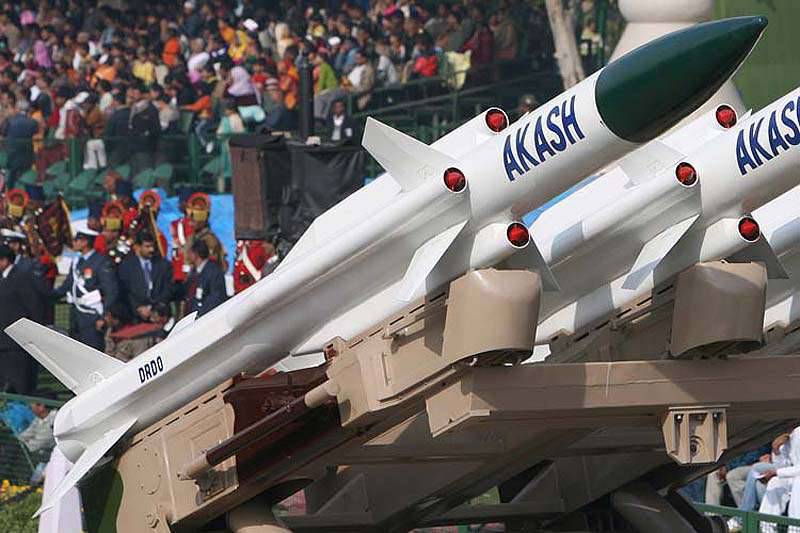
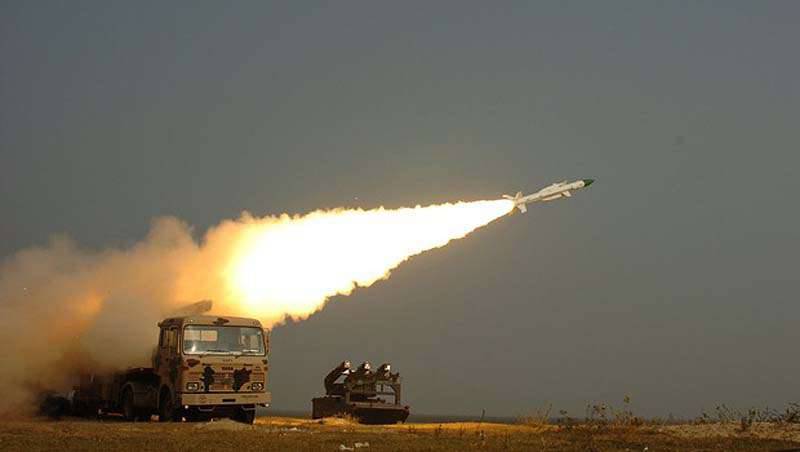
Akash short-range missile last year entered service with the Indian army
Tactical connection
The program currently postponed by the tactical communications system TCS (Tactical Communication System) aims to unite the troops deployed on the battlefield in a single network-centric space. Its implementation will make it possible to create a modern battle management system in which commanders at the tactical level can exchange updated situation data, geospatial data and maintain communications at the level of battle formations.
“For a project of this scale, state enterprises are sometimes more suitable because they are better equipped, their time and expenses are under control, and they are historically more stable in order to sustain such a project,” a representative of Roland Berger Strategy Consultants expressed his opinion.
Indian consortium BEL / Rolta received a contract for the implementation of TCS. According to the director of the company BEL, “the consortium is fully prepared to perform the complex task of developing a battle management system.” “We also strive to maximize the share of local components by developing various subsystems within the country,” said the managing director of Rolta India. “The choice of Rolta is a direct proof of our investment strategy and the creation of world-class Indian intellectual property.”
This intellectual development company Rolta based on the experience of creating automated control systems, which are already in service with various units of the Indian army. As part of the consortium, Rolta will develop software for the battle management system, geographic information system software and data processing, as well as licensing. Rolta will also manufacture, in conjunction with the BEL subsystem, the integration and commissioning of the entire system and its maintenance.
FICV program
Currently, in the framework of the public-private partnership of DRDO, the army and the company Tata Motors, the floating wheel platform FICV is being developed, which has now passed the running, fire tests and buoyancy tests.
Tata believes that by successfully demonstrating its ability to build armored vehicles, it can hope to win the FICV project. There are ten bidders for the FICV project worth 9 billion dollars. Again, in the framework of the Do in India mantra, the goal of this program is to replace roughly 1400 Russian 2600 BMPs with FICV platforms. According to some estimates, the cost of the program may eventually grow to 15 billion dollars.
The deadline for submitting responses to the RFP issued by the Ministry of Defense was 15 February 2016. In line with the "Make in India" slogan, the Ministry granted OFB and two other applicants the right to design and develop the FICV. A letter from the ministry, sent out to ten applicants, states that two private Indian companies will be selected for the competition. The ten applicants include L&T, Tata Power (SED), Mahindra & Mahindra, Bharat Forge, Pipavav Defense, Rolta India, Punj Lloyd and Titagarh Wagons. The request for proposals states that the FICV vehicle should be transported by Il-76 and C-17 military transport aircraft and fire anti-tank guided missiles at a range of up to 4000 meters.
Medium tank
Another big project on the agenda is the medium tank FRCV, which will replace obsolete army Tanks T-72. To eliminate some confusion, Parikar confirmed in August 2015 that the Indian Army’s requirements for a medium tank did not contradict the Arjun main battle tank (MBT) program. He added that the FRCV platforms “must meet future requirements beyond 2027 and should not affect Arjun MBT orders.”
The request for information states that there is a need for FRCV 2545 machines and besides the medium tank this platform should become the basis for a modular family of vehicles: tracked MBT (basic variant); light tracked tank; light wheeled tank; tank bridge laying; mine sweep and mine plow. The family also includes a repair and recovery vehicle, a self-propelled artillery installation and an anti-aircraft missile and gun installation. The request for information issued last year includes design and development in three phases. The army wants to be the first to see the submitted projects, of which it will select two projects that the government will pay for. Then these two companies will be able to argue for a production contract, after which, finally, the best project will be selected and transferred to the Production Agency.
Among the foreign companies that are most likely to take part in the competition are Rafael, General Dynamics and Uralvagonzavod. The terms of the competition provide for the establishment of close cooperation with large Indian companies. In addition, nine more companies will collaborate on technology transfer, including in-house production of the tower, as well as 22 of 34 mobility-related technologies. It is assumed that these will be BAE Systems, Mahindra & Mahindra, Tata Motors, Dynamatic Technologies, as well as local related businesses such as Punj Lloyd, Bharat Forge, Titagarh Wagons and Pipavav Defense.
Companies participating in the FICV project will also be able to take part in the competition for the FRCV platform in parallel, since these projects are expected to have some level of uniformity among the various subsystems, including protection, actuators, suspensions and enclosures.
In addition, Tata Motors has received an order to supply 1239 highly mobile trucks worth 135 million dollars. The 6xXNNMX locally developed wheeled trucks must be delivered to the Indian Army within two years. Other Buy Indian offerings include an advanced light helicopter, BrahMos missiles, Pinaka multiple rocket launchers, upgrades to the BMP-6 / 2K and Arjun MBT.
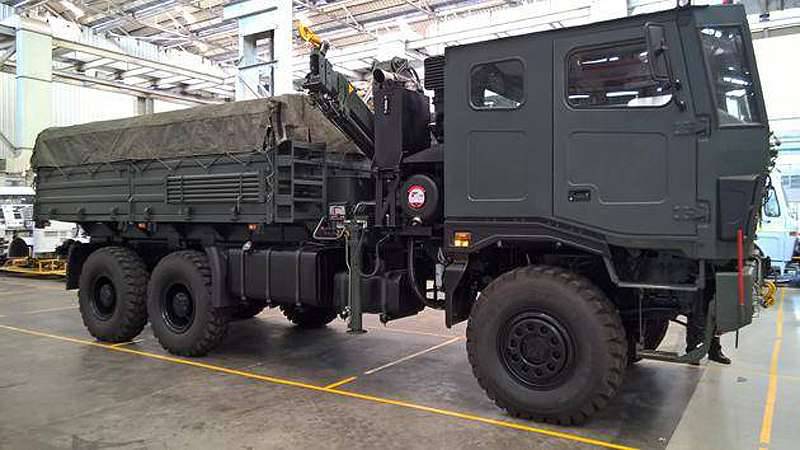
1239 trucks will be delivered by Tata Motors to the Indian army
Buy and make in India offerings include anti-aircraft installations as a replacement for existing L / 70 and Doo-23 installations, Light Armored Mobility Vehicle (LAMV) light armored vehicle for mechanized units and T-90 mine plows. Tata Motors showed a prototype LAMV at Defexpo India in February 2014. Despite the slogans “Buy and Do in India”, LAMV was developed with the technical assistance of the British company Supacat.
Metallurgical Moratorium
“For the first time, the Indian army is negotiating with the private sector for spare parts and maintenance,” General Shankar admitted. “More participants are welcome, especially in the production of titanium, which is still in its infancy.” Titanium is a light metal and, due to its excellent corrosion resistance and high specific strength, is widely used in the aerospace industry.
"The metallurgical industry could not deliver normal products that would meet stringent requirements, and therefore the modernization of the army engineering corps was very slow," said a representative of this corps. - “Do it in India” does not always bring positive results. Take the Sarvatra bridge system with a span of 75 meters, which consists of five scissors bridges made of aluminum alloy. The bridge with a span of 15 meters is installed on a separate modified chassis of a Tatra 815 VVN 8x8 truck. ”
“The equipment must withstand tough operation, and the bridge cracked in the hinges and was returned for revision,” complains a military engineer. - It is sad. After all, bridge guidance systems ensure the mobility of the main forces. ”
L&T, with the participation of DRDO, is the main bridge manufacturer. “We have problems with the supply of local metallurgical plants, the quality is not always good and we have to import billets,” said an L&T spokesman. He added that the gap between the prototype and the final product is too large. The technology becomes obsolete every five years. "
In the field of mine business there were also problems. A military engineer said that "the corps must manually lay mines." A request for proposals was issued on the mine-laying system; following the results of the competition, Bharat Forge was selected as the main supplier, but the troop tests of this vehicle had not yet begun. In addition, six requests for proposals have been published (three more are expected) on equipment for the countering of improvised explosive devices, which is currently being bought mainly abroad.
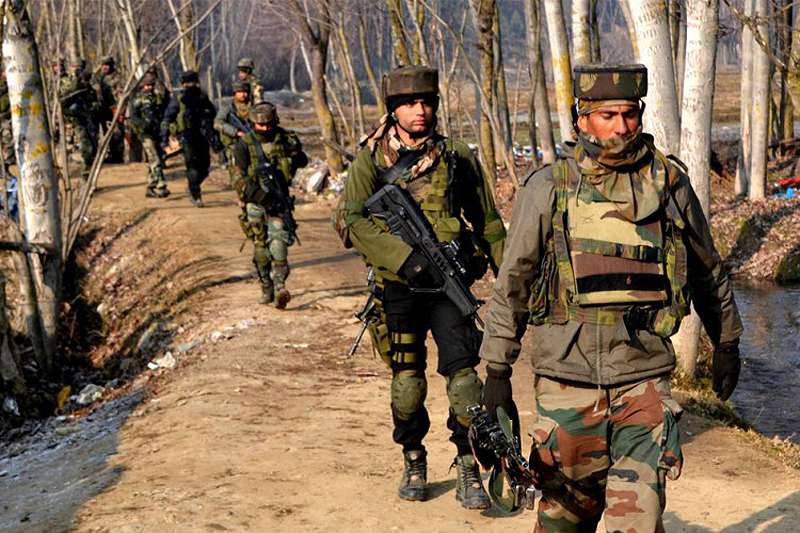
The army intends to purchase the first 50000 light armor for its soldiers who are not spoiled by delights
Air defense
Last year, the Akash rocket came into service with the Indian army. The short-range air-to-surface missile has a maximum range of 25 km and an altitude of 20 km. The share of Indian content in the rocket is 96%. She is advertised as a successful project in the “Make in India” program. Large quantities of the Barak 8 rocket, a joint development with Israel, are expected. Last year there were successful launches.
“The strategy is a balanced combination of ground-to-air missiles and weapon systems, and there is a phased program for this,” said General Singh. - But the main thing is pace. Although the Akash and Barak 8 missiles were included in the procurement programs of the Indian army, by and large, their supplies are out of schedule. ” He believes that these delays are related to the current policy, whose limiting factor is the restriction of foreign direct investment to 49%, “which does not give the investor significant benefits.”
Materials used:
www.shephardmedia.com
www.mod.nic.in
www.drdo.gov.in
www.wikipedia.org
en.wikipedia.org
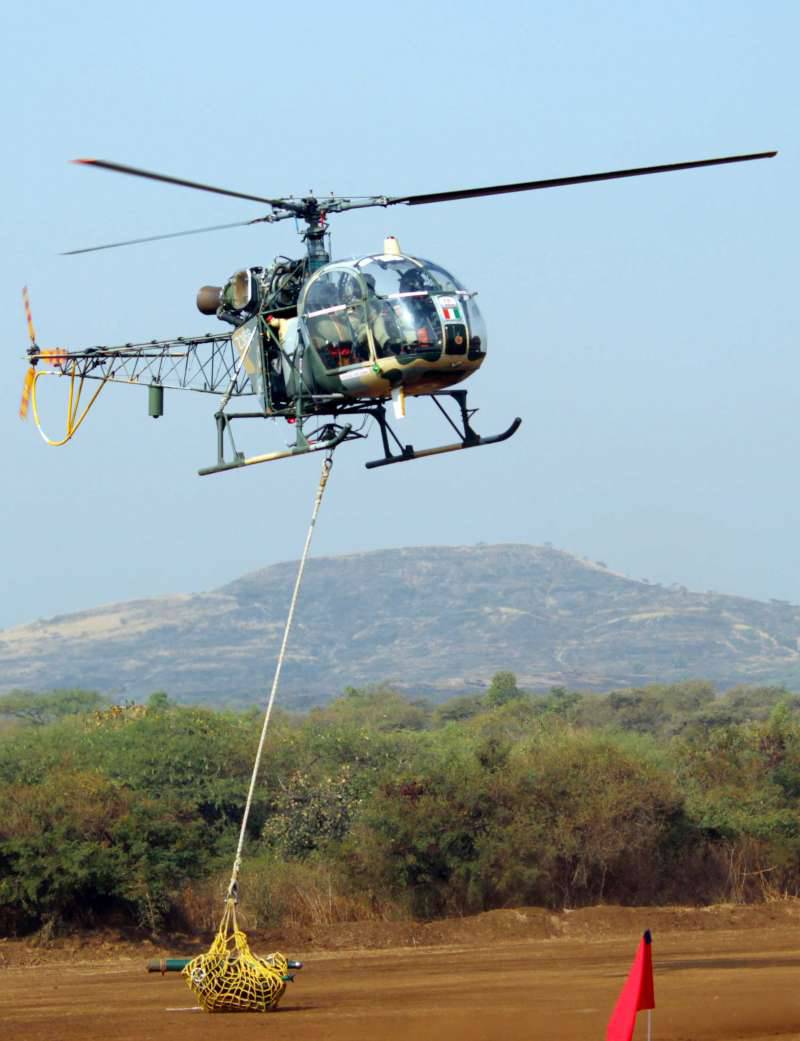
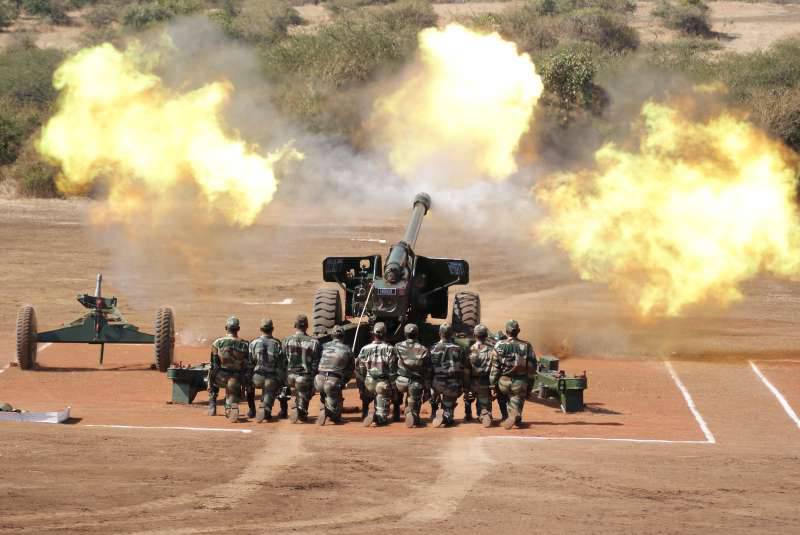
Information